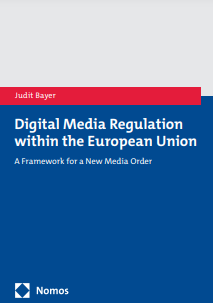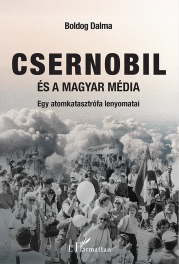Keyword – media freedom
Polyák, Gábor:
Polyák, Gábor:
Regulation of public advertising in the draft European Media Freedom Act
The volume and discriminatory distribution of state advertising is one of the most serious problems of the Hungarian media system and media freedom. The original draft of the European Media Freedom Act and the amendments proposed by the LIBE Committee of the European Parliament and of the Council are important attempts to curb this uncontrolled public spending. This paper shows what the European regulatory proposal offers as a solution and how it may be interpreted in the light of the previous practice of the European institutions.
Keywords: EMFA, media freedom, public spending, state advertising, transparency
Regulation of public advertising in the draft European Media Freedom Act
Médiakutató Autumn 2023 pp. 51-56 https://doi.org/10.55395/MK.2023.3.6
Bayer, Judit:
Bayer, Judit:
EMFA: is an equilibrium of powers possible? The perspectives of NRA independence in the EU media landscape
The cornerstones of the regulatory model proposed by EMFA are the independent media authorities, which will be brought together in a new Board. This would link the Commission, which monitors the application of EU principles, with the sovereign media authorities in the Member States. A deficit in the independence of the authorities not only jeopardises the EMFA, but also threatens to undermine European standards. Although Article 30 of the AVMS Directive makes the independence criteria mandatory from 2020 onwards, in some states (such as Hungary) these are not met or are only formally met. This analysis recalls that there already is a methodology for assessing de facto independence instead of formal independence. It recalls the paradox of the legal regulation of independence and points out that the application of the principle of equidistance rather than a negative interpretation of independence (immunity from something) seems to be the new European direction. According to this approach, the actors would mutually control each other and counterbalance each other’s influence.
Keywords: EMFA, independence of the media, independence of NRAs, media freedom, regulatory model
Médiakutató Autumn 2023 pp. 25-33 https://doi.org/10.55395/MK.2023.3.3
Gálik, Mihály:
Gálik, Mihály:
Setting about
The launch of satellite television services in the 1980s challenged the regulation of the television industry in Europe as these services, called television without frontiers (TWF), emerged on the previously closed markets of European countries. The need for a common regulatory framework within the European Economic Community (EEC) led to the enacting of the TWF directive in 1989. Responding to technical and economic innovations in the television industry, the TWF directive was modified decade after decade. The recent proposal for regulation by the European Parliament and the Council (the European Media Freedom Act, abbreviated EMFA) is to establish a common framework for media services in the internal market and is amending directive 2010/13/EU on audiovisual services. EMFA covers all media services and as such it is representing a legal innovation within the European Union
Keywords: European Union, market, media freedom, media services, regulation
Médiakutató Autumn 2023 pp. 9-14 https://doi.org/10.55395/MK.2023.3.1
Sükösd, Miklós:
Sükösd, Miklós:
Censorship murders ideas
This paper analyses the sources, historical and biographical context and political significance of Freedom of the press: Views of a prisoner, an influential book in 1844 by Mihály Táncsics (1799–1884). Táncsics was a radical democratic, left-wing Hungarian writer, teacher, publisher and politician. He played an important role in the 1848 anti-Habsburg democratic revolution and as the publisher of the first peasant and worker newspapers in Hungary. The American constitutional and press system served as Táncsics’ main inspiration for the demand for unrestricted press freedom. His other sources included Enlightenment ideas (rationality, natural law and social contract theory), Hungarian progressive patriotic reformism of the early 19th century, and utopian socialism. Although Táncsics as a theorist of press freedom became rather influential, his plebeian press publishing efforts remained limited, due to low literacy rates among peasants and the slow post-feudal development of social structure in Hungary. In general, people’s Enlightenment or deep Enlightenment (as opposed to elite Enlightenment) could not take place in the country. This pattern has longue durée consequences for mediapolitics relations and the chances for democratisation in Hungary.
Keywords: bourgeois public sphere, censorship, deep Enlightenment, media freedom, plebeian public sphere, press history, print culture, printing, samizdat, tamizdat
Médiakutató Summer 2021 pp. 91-104
Bátorfy, Attila:
Bátorfy, Attila:
Hungary: A Country on the Path Toward an Authoritarian Media System
The erosion of the freedom of press in Hungary is a constantly and well-documented fact, accessible to foreign visitors. Political science has competing theories for a systemic understanding of the Hungarian political establishment, but theoretical approaches to the characteristics of the Hungarian media landscape are sporadic and incomplete. In this paper, based on a description of the properties of the Hungarian media system, which has been arbitrarily transformed by the Orbán governments in power since 2010 through administrative-regulatory, state funding and communication tools, I attempt to situate it between classical and recent media system theories and thus complement the observations made so far with some new ones. I will point out that Orbán’s authoritarian ideas about the media have been clear at least since his first government and argue that although the Hungarian media system, despite its mixed features, does not fit into any media system theory, this is only because these theories draw the contours of the dynamically changing media spaces after the fact. Recognising this, I believe, can help us to identify archetypes of media systems when examining the relationship between power and media. I will do this through an illustration of the tools and their effects used for authoritarian media transformation and will argue that the Hungarian media system, among the categories established by Siebert, Peterson and Schramm, is similar in its dynamics to the authoritarian and the Soviet-communist media systems.
Keywords: freedom of press, media and politics, media freedom, media system theories
Hungary: A Country on the Path Toward an Authoritarian Media System
Médiakutató Autumn-Winter 2022 pp. 49-58



